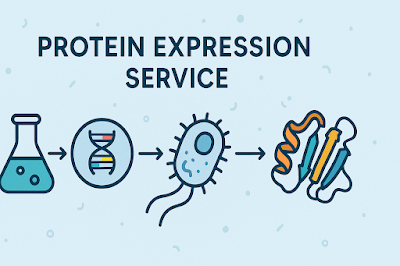How to Select a Recombinant Protein Expression Service That Delivers Results
As a molecular biologist tackling complex protein studies, I know firsthand how critical it is to select the right Recombinant Protein Expression Service. A misstep in this decision can waste weeks or even months of precious time, not to mention the financial and academic costs. That’s why I’m sharing my journey—how I made this choice, what lessons I learned, and how I ultimately partnered with Lytic Solutions, LLC, a name I now trust and recommend for fellow researchers.
My Research Needs: A Starting Point
I was working on a project focused on signaling pathways in
cancer biology. Specifically, I needed high-quality recombinant proteins for
downstream applications like pull-down assays, crystallography, and enzyme
kinetics. Because these experiments are unforgiving when it comes to protein
purity and activity, I needed a service that could deliver both quality and
customization.
Initially, I thought I could handle expression in-house
using our lab’s E. coli system. But after repeated issues with solubility and
batch-to-batch variability, I knew it was time to outsource to a professional Recombinant
Protein Expression Service.
Step 1: Clearly Defining My Criteria
Before contacting any vendors, I sat down and mapped out
what I needed. This included:
- Expression
system compatibility (E. coli, yeast, insect, or mammalian)
- Post-translational
modification capability
- Scale
of production (mg to gram quantities)
- Purity
requirements (>95%)
- Turnaround
time
- IP
protection and confidentiality
- Customization
and support
Having this list helped me filter services that matched my
technical requirements. It’s something I recommend every researcher do. It
saves time and ensures your vendor conversations are focused.
Step 2: Deep Dive into Reputation and Expertise
I didn’t want just a generic CRO. I needed experts who
specialize in Recombinant
Protein Expression Service. My initial shortlist included five
companies. I read reviews, peer forums, and even dug through acknowledgments in
published papers to see who others in the field were using.
That’s when I came across Lytic Solutions, LLC. I noticed
their name appeared in a few reputable journal acknowledgments, especially in
cancer biology research. That was my first sign they might be a good fit.
Step 3: Reviewing Case Studies and Portfolios
A trustworthy service will be transparent about their past
work. When I visited the Lytic Solutions, LLC website, I was impressed with
their technical documentation. They showcased case studies involving
hard-to-express proteins, complex post-translational modifications, and
scalable production for both academia and biotech.
I particularly appreciated their emphasis on collaborative
communication, a point that turned out to be a game changer later in my
project.
Step 4: Assessing Customization and Support
Some companies offer fixed expression packages, but my
project required flexibility—construct design, codon optimization, and affinity
tag selection. When I reached out to Lytic Solutions, LLC, they responded
within 24 hours with a detailed questionnaire tailored to my project. Then came
a Zoom call with their technical director.
This wasn’t a sales pitch—it was a deep dive into my goals,
challenges, and deadlines. They even reviewed my existing constructs to advise
on optimization, at no extra charge. That level of support was unique compared
to other services I contacted.
Step 5: Understanding Cost vs. Value
Let’s be honest: budget matters. But I’ve learned not to
make decisions solely based on cost. One provider offered rock-bottom pricing,
but they had no mammalian expression capability and minimal QC transparency.
Another quoted double the average market rate, offering no apparent added
value.
Lytic Solutions, LLC fell right in the middle. Their pricing
was transparent and broken down by milestone: gene synthesis, vector
construction, expression trials, scale-up, and purification. They also included
optional add-ons like endotoxin testing and biophysical characterization.
I appreciated that there were no hidden costs and I could
scale the service based on my available funding.
Step 6: Running a Pilot Before Full Commitment
Before committing to a large-scale production, I ran a pilot
expression and purification with Lytic Solutions. This is something I strongly
recommend: test your provider with a smaller project first.
The pilot included expression in E. coli and HEK293 systems.
Not only did they provide detailed SDS-PAGE and Western blot reports, but they
also delivered side-by-side activity assay results comparing both systems. That
level of transparency gave me full confidence to proceed with the full batch.
Step 7: Post-Delivery Support and Communication
Some services vanish once the job is done. Lytic Solutions
didn’t. After delivery, they followed up with usage recommendations, storage
tips, and even scheduled a feedback session. When I ran into issues with
protein stability at 4°C, they provided buffer modification suggestions and
even offered to run a stability test themselves—no charge.
Their communication was stellar throughout. I was assigned a
project lead, which made everything more efficient and personal.
Lessons Learned
If you’re seeking the best Recombinant Protein Expression
Service, here are my key takeaways:
- Define
your exact needs – Know your target protein’s requirements before
shopping for a vendor.
- Research
reputations – Look for published work, academic references, and case
studies.
- Customize,
don’t compromise – Choose a partner who adapts to your goals, not a
one-size-fits-all service.
- Pilot
first – Always test with a small-scale run to evaluate quality and
communication.
- Value
support – Post-project assistance can be a lifesaver when something
goes wrong in your downstream steps.
Final Thoughts
Choosing the right Recombinant Protein Expression Service
has been one of the most impactful decisions in my research career. With the
wrong partner, you risk unreliable data and wasted time. With the right one,
like I found in Lytic Solutions, LLC,
you gain a long-term collaborator who elevates your science.
If you’re ready to take your research to the next level, do your homework, run that pilot, and don’t settle. Trust your instincts—but verify with data and support. That’s what led me to success, and it can do the same for you.




Comments
Post a Comment